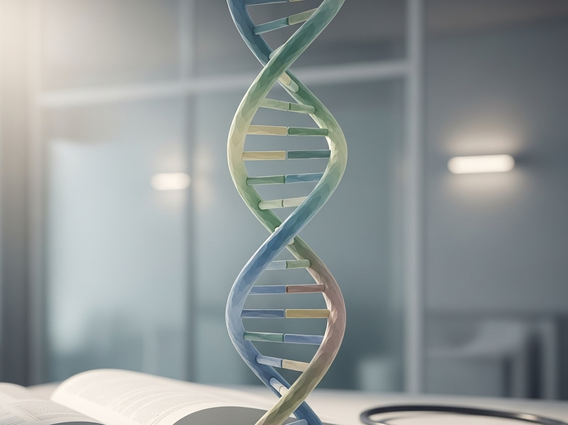Family History and Cancer Risk
Understanding your family’s health history is a powerful tool in assessing your personal cancer risk. While not every cancer is inherited, a significant portion can be influenced by genetic factors passed down through generations, making awareness a critical first step in prevention and early detection.

Key Takeaways
- A detailed family history is crucial for identifying potential inherited cancer risks.
- Specific genetic mutations can significantly increase the likelihood of developing certain cancers.
- Regular cancer risk assessment based on family history guides personalized screening and prevention strategies.
- Genetic testing offers insights into inherited predispositions, enabling informed health decisions.
- Lifestyle modifications and early detection remain vital even with an elevated family history cancer risk.
Understanding Your Family History and Cancer Risk
The journey to understanding your personal cancer risk often begins with a close look at your family tree. The presence of cancer in multiple relatives, especially at younger ages, can signal an increased predisposition. This awareness is fundamental to managing your health proactively.
What defines a significant family history cancer risk?
A significant family history of cancer isn’t just one relative having cancer; it often involves specific patterns. These can include multiple close relatives (parents, siblings, children) on the same side of the family diagnosed with the same type of cancer, or related cancers (e.g., breast and ovarian cancer). Early-onset diagnoses (before age 50) and rare cancers also raise flags. Recognizing these patterns is key to understanding your potential family history cancer risk.
Recognizing inherited cancer risk factors.
Many cancers are sporadic, meaning they occur by chance or due to environmental factors. However, a notable percentage are hereditary, meaning they are linked to specific gene mutations passed down through families. These inherited cancer risk factors can significantly increase an individual’s lifetime risk of developing certain cancers. Identifying these factors early allows for targeted surveillance and prevention strategies.
The basics of how family history affects cancer risk.
Your family history provides clues about shared genetic mutations, environmental exposures, and lifestyle habits that might contribute to cancer development. For instance, if several family members have smoked and developed lung cancer, it points to a combination of genetic susceptibility and environmental influence. Conversely, a strong pattern of a specific cancer type across generations, even in non-smokers, might indicate a strong genetic link. This illustrates how family history affects cancer risk, guiding both individuals and healthcare providers.
Key Indicators of a Significant Family History
- Multiple close relatives (first- or second-degree) with the same or related cancers.
- Cancer diagnosed at an unusually young age (e.g., breast cancer before 50).
- Presence of rare cancers in the family.
- Cancers occurring in both paired organs (e.g., bilateral breast cancer).
- Multiple primary cancers in the same individual.
How Genetics Influence Family History Cancer Risk
The intricate world of genetics plays a profound role in determining an individual’s susceptibility to cancer. While not every cancer is hereditary, specific genetic mutations can significantly elevate the family history cancer risk, making it crucial to understand these underlying mechanisms.
The role of genetics and cancer risk in families.
At the heart of hereditary cancers are germline mutations – genetic changes present in every cell of the body, passed down from a parent to a child. These mutations often affect genes responsible for repairing DNA damage or controlling cell growth. When these genes don’t function correctly, cells are more prone to accumulating further mutations, leading to cancer. This direct link highlights the critical role of genetics and cancer risk within a family unit.
Identifying common inherited cancer risk factors.
Several well-known genes are associated with increased cancer risk. For example, mutations in BRCA1 and BRCA2 genes are strongly linked to hereditary breast and ovarian cancers. Lynch syndrome, caused by mutations in MLH1, MSH2, MSH6, and PMS2 genes, significantly increases the risk of colorectal and endometrial cancers. Other genes like TP53 (Li-Fraumeni syndrome) and APC (Familial Adenomatous Polyposis) also represent significant inherited cancer risk factors. Awareness of these specific genetic links empowers individuals and families to take proactive steps.
Understanding family cancer history patterns.
Hereditary cancer syndromes typically follow an autosomal dominant inheritance pattern. This means that if one parent carries a mutated gene, there’s a 50% chance their child will inherit it. This pattern often results in cancer appearing across multiple generations, affecting both males and females. Documenting the types of cancer, ages of diagnosis, and relationships among affected family members helps in understanding family cancer history and identifying potential hereditary syndromes. This detailed mapping is invaluable for risk assessment.
Common Inherited Cancer Syndromes and Associated Cancers
This table illustrates some of the most common inherited cancer syndromes and the primary cancers associated with them, emphasizing the impact of genetics and cancer risk.
| Syndrome | Associated Genes | Primary Cancers |
|---|---|---|
| Hereditary Breast and Ovarian Cancer (HBOC) | BRCA1, BRCA2 | Breast, Ovarian, Prostate, Pancreatic, Melanoma |
| Lynch Syndrome (HNPCC) | MLH1, MSH2, MSH6, PMS2, EPCAM | Colorectal, Endometrial, Ovarian, Gastric, Urinary Tract |
| Familial Adenomatous Polyposis (FAP) | APC | Colorectal (numerous polyps), Duodenal, Thyroid, Desmoid Tumors |
| Li-Fraumeni Syndrome | TP53 | Sarcoma, Breast, Adrenocortical Carcinoma, Brain Tumors, Leukemia |
| Cowden Syndrome | PTEN | Breast, Thyroid, Endometrial, Colorectal |
Assessing Your Family History Cancer Risk
Once you recognize the potential for an elevated family history cancer risk, the next crucial step is a thorough assessment. This process involves gathering comprehensive information and often consulting with healthcare professionals specializing in cancer genetics.
Steps for cancer risk assessment family history.
The initial step in cancer risk assessment family history involves systematically collecting information about your biological relatives. This includes both your mother’s and father’s sides of the family, extending to grandparents, aunts, uncles, cousins, and children. Once this information is compiled, it should be shared with your primary care physician, who can then help determine if further specialist consultation is warranted.
Gathering crucial details for family history cancer risk.
To make your family history as informative as possible, strive to gather specific details. For each relative who has had cancer, try to ascertain the type of cancer, their age at diagnosis, and the outcome of their treatment. Knowing if they had multiple primary cancers or if any rare cancers were present is also highly valuable. This detailed information paints a clearer picture of your potential family history cancer risk and helps identify specific patterns.
Consulting specialists for inherited cancer risk factors.
If your family history suggests a significant risk, your doctor may refer you to a genetic counselor or a cancer geneticist. These specialists are experts in hereditary cancer syndromes. They can analyze your family tree, discuss the likelihood of specific inherited cancer risk factors being present, and explain the benefits and limitations of genetic testing. Their guidance is invaluable in navigating complex genetic information and making informed decisions about your health.
Essential Information to Collect for Your Family History
- Names of all first- and second-degree relatives (parents, siblings, children, grandparents, aunts, uncles, nieces, nephews).
- Any known health conditions, especially cancer.
- For each cancer diagnosis:
- Type of cancer (e.g., breast, colon, ovarian).
- Age at diagnosis.
- Whether the cancer occurred in one or both paired organs (e.g., bilateral breast cancer).
- If the individual had multiple primary cancers.
- Ethnic background, as some genetic mutations are more common in certain populations.
- Any known genetic testing results for family members.
Managing Elevated Family History Cancer Risk
For individuals identified with an elevated family history cancer risk, proactive management becomes paramount. This involves a personalized approach that often combines increased surveillance, lifestyle adjustments, and sometimes preventative medical interventions.
Strategies for those with high family history cancer risk.
When a significant family history cancer risk is identified, strategies often shift from general population guidelines to more intensive, personalized plans. This can include more frequent screenings, starting at an earlier age, or using more advanced screening technologies. For example, individuals with a strong family history of breast cancer might undergo annual mammograms and MRI scans. In some cases, preventative (prophylactic) surgeries, such as a mastectomy or oophorectomy, might be considered to significantly reduce risk.
Proactive steps for inherited cancer risk factors.
Beyond increased screening, individuals with known inherited cancer risk factors can take several proactive steps. These include adopting a healthy lifestyle, which encompasses a balanced diet, regular physical activity, maintaining a healthy weight, and avoiding tobacco and excessive alcohol consumption. Chemoprevention, the use of certain medications to reduce cancer risk, may also be an option for some individuals, depending on their specific genetic mutation and cancer risk profile.
Personalized plans based on genetics and cancer risk.
The most effective management plans are those tailored to an individual’s specific genetic profile and overall cancer risk. A genetic counselor or oncologist can help develop a comprehensive plan that integrates screening schedules, lifestyle recommendations, and potential medical interventions. This personalized approach, informed by an understanding of genetics and cancer risk, ensures that individuals receive the most appropriate and effective care to mitigate their elevated risk.
Key Strategies for Managing Elevated Risk
- Enhanced Surveillance: More frequent screenings (e.g., colonoscopies, mammograms, MRIs) starting at an earlier age than general population guidelines.
- Chemoprevention: Use of medications (e.g., tamoxifen for breast cancer risk) to reduce the likelihood of cancer development.
- Prophylactic Surgery: Consideration of risk-reducing surgeries (e.g., mastectomy, oophorectomy) in high-risk cases.
- Lifestyle Modifications: Adopting a healthy diet, regular exercise, maintaining a healthy weight, and avoiding smoking and excessive alcohol.
- Regular Consultations: Ongoing discussions with genetic counselors, oncologists, and other specialists to review risk and adjust management plans.
Genetic Testing for Family History Cancer Risk
For many individuals with a significant family history cancer risk, genetic testing offers a powerful tool to clarify their inherited predisposition. This advanced diagnostic method can identify specific gene mutations that increase cancer susceptibility, enabling highly personalized risk management.
When to consider genetic testing for cancer risk.
Genetic testing is not recommended for everyone, but it becomes a crucial consideration when a detailed family history suggests a hereditary cancer syndrome. Indicators include multiple family members with the same or related cancers, early-onset cancers, rare cancers, or specific patterns like bilateral cancers. A genetic counselor can assess your family history and determine if genetic testing for cancer risk is appropriate for you, discussing the potential benefits and limitations.
Interpreting results of genetic testing for cancer risk.
The results of genetic testing for cancer risk can be complex. A “positive” result means a specific gene mutation associated with increased cancer risk was found. A “negative” result indicates no known mutation was detected, but it doesn’t eliminate all cancer risk. Sometimes, a “variant of uncertain significance” (VUS) is found, meaning the clinical impact of the genetic change is not yet clear. Interpreting these results requires expert guidance from a genetic counselor to understand their implications for your health and your family.
Impact of genetic testing on family history cancer risk.
The information gained from genetic testing can profoundly impact how an individual and their family manage their family history cancer risk. A positive result can lead to highly personalized screening protocols, preventative measures, and even targeted treatment options if cancer develops. It also provides crucial information for other family members who may also carry the mutation. This knowledge empowers individuals to make informed decisions about their health and future, potentially saving lives through early detection and prevention.
Benefits of Genetic Testing
- Personalized Risk Assessment: Provides a more precise understanding of individual cancer risk.
- Informed Medical Decisions: Guides decisions on screening frequency, preventative surgeries, and chemoprevention.
- Family Planning: Offers insights for family members who may also be at risk.
- Targeted Treatment Options: Can inform specific treatment choices if cancer is diagnosed.
- Reduced Anxiety: For some, a negative result can alleviate concerns, while a positive result can empower proactive management.
Reducing Your Family History Cancer Risk
Even with an elevated family history cancer risk, there are numerous proactive steps you can take to significantly reduce your chances of developing cancer. Combining genetic awareness with healthy lifestyle choices and diligent screening forms a powerful defense.
Lifestyle choices to mitigate family history cancer risk.
Lifestyle plays a crucial role in cancer prevention, even for those with genetic predispositions. Adopting a healthy diet rich in fruits, vegetables, and whole grains, while limiting processed foods and red meat, can be beneficial. Regular physical activity, maintaining a healthy weight, and avoiding tobacco and excessive alcohol consumption are also vital. These proactive lifestyle choices to mitigate family history cancer risk work by supporting overall health and reducing cellular damage that can lead to cancer.
Early detection for inherited cancer risk factors.
For individuals with known inherited cancer risk factors, early detection is paramount. This often means adhering to more frequent and specialized screening schedules than the general population. For example, someone with a BRCA mutation might begin mammograms and breast MRIs at an earlier age. Regular check-ups, self-exams, and prompt attention to any unusual symptoms are also critical. The goal is to detect any potential cancer at its earliest, most treatable stage.
How understanding family cancer history aids prevention.
A thorough understanding family cancer history empowers individuals to take control of their health. It allows for informed discussions with healthcare providers, leading to personalized screening plans and preventative strategies. Knowing your family’s patterns helps you recognize your own potential risks and motivates you to make lifestyle changes and adhere to screening recommendations. This knowledge transforms a potential vulnerability into an opportunity for proactive health management and significantly aids in prevention efforts.
Proactive Measures for Risk Reduction
- Healthy Diet: Focus on plant-based foods, lean proteins, and limit processed foods, red meat, and sugary drinks.
- Regular Exercise: Aim for at least 150 minutes of moderate-intensity or 75 minutes of vigorous-intensity aerobic activity per week.
- Maintain a Healthy Weight: Obesity is a known risk factor for several cancers.
- Avoid Tobacco and Limit Alcohol: These are significant, modifiable cancer risk factors.
- Adhere to Screening Guidelines: Follow personalized screening schedules recommended by your doctor or genetic counselor.
- Know Your Body: Be aware of any changes and report them promptly to your healthcare provider.
Frequently Asked Questions About Family History and Cancer Risk
How accurate is my family history in predicting my cancer risk?
Your family history is a powerful indicator, but it’s not a definitive predictor. It helps identify patterns and potential inherited predispositions, guiding further assessment. While a strong family history increases the likelihood of an elevated risk, it doesn’t guarantee you will develop cancer, nor does a lack of family history mean you are immune. It’s one piece of a larger puzzle that includes genetics, lifestyle, and environmental factors.
Healthcare professionals use family history to determine if you meet criteria for genetic counseling or testing, which can provide more precise risk assessments. It’s a starting point for a conversation about personalized prevention and screening strategies.
If I have a family history of cancer, does that mean I will definitely get cancer?
No, having a family history of cancer does not mean you will definitely get cancer. It means your risk might be higher than someone with no family history. Many factors contribute to cancer development, and genetics are just one component. Lifestyle choices, environmental exposures, and chance all play significant roles.
Understanding your family history empowers you to take proactive steps, such as increased surveillance and healthy lifestyle choices, which can significantly reduce your risk even if you have a genetic predisposition. It’s about managing risk, not predicting destiny.
What kind of information should I collect about my family’s cancer history?
To provide the most useful information to your doctor, try to collect details on all first- and second-degree relatives (parents, siblings, children, grandparents, aunts, uncles, nieces, nephews) on both sides of your family. For each relative who had cancer, note the type of cancer, their age at diagnosis, and if they had multiple primary cancers.
Also, include information on any known genetic testing results in the family. The more specific and comprehensive your information, the better your healthcare provider can assess your personal risk and guide appropriate next steps.
Can lifestyle changes reduce my cancer risk even if I have a strong family history?
Absolutely. Lifestyle choices have a significant impact on cancer risk, even for individuals with a strong family history or known genetic mutations. Adopting a healthy diet, engaging in regular physical activity, maintaining a healthy weight, avoiding tobacco, and limiting alcohol consumption can all help mitigate your risk.
These healthy habits support your body’s natural defenses and can reduce the likelihood of cancer development, working in conjunction with any recommended medical surveillance or preventative measures.
When should I consider genetic testing for cancer risk?
You should consider genetic testing for cancer risk if your family history shows patterns suggestive of a hereditary cancer syndrome. This includes multiple relatives with the same or related cancers, cancers diagnosed at an early age (e.g., under 50), rare cancers, or if a known cancer-causing gene mutation has been identified in a family member.
It’s best to discuss your family history with your doctor or a genetic counselor. They can assess your specific situation, explain the potential benefits and limitations of testing, and help you decide if genetic testing is the right step for you.





